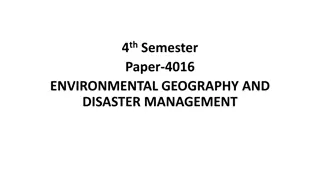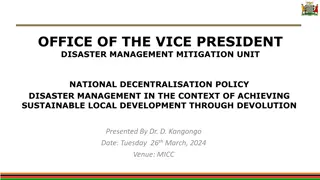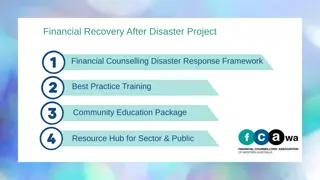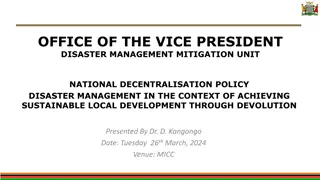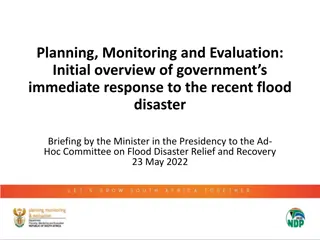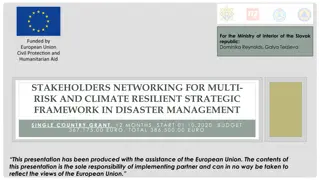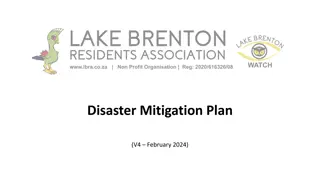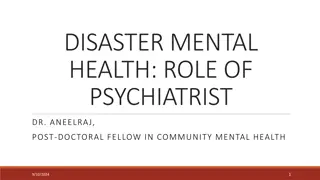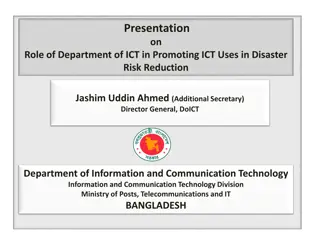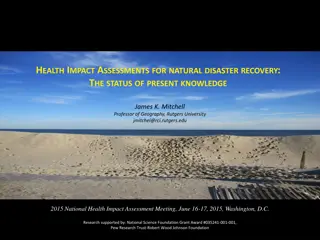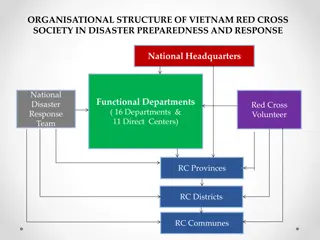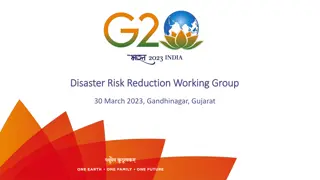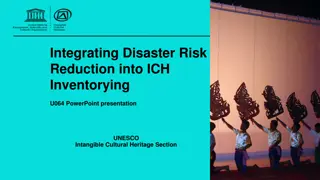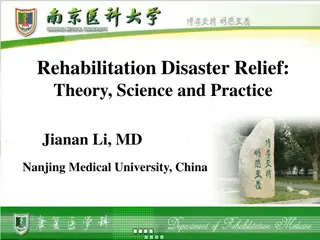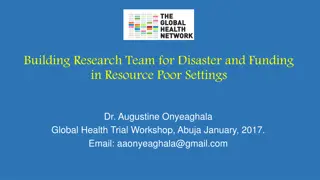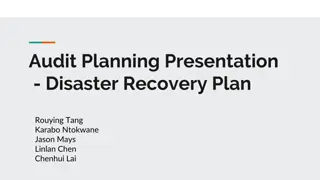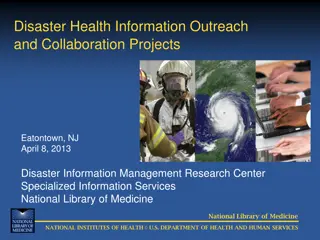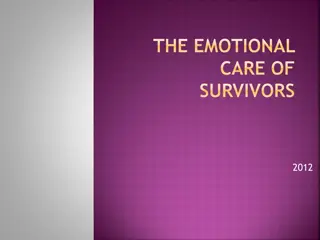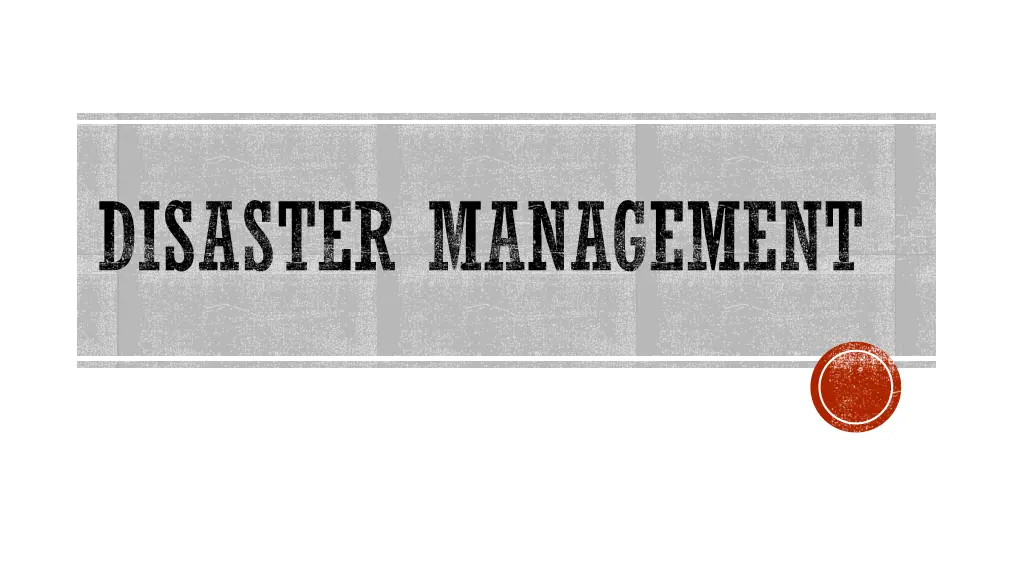
Understanding Disaster Management Fundamentals
Explore the essentials of disaster management, including types of disasters, disaster response, preparedness, and mitigation strategies. Learn about natural and man-made disasters, government agencies responsible for early warnings, and steps for disaster preparedness. Discover how disaster mitigation aims to prevent emergencies and reduce negative impacts through hazard risk analysis and proactive measures.
Download Presentation

Please find below an Image/Link to download the presentation.
The content on the website is provided AS IS for your information and personal use only. It may not be sold, licensed, or shared on other websites without obtaining consent from the author. If you encounter any issues during the download, it is possible that the publisher has removed the file from their server.
You are allowed to download the files provided on this website for personal or commercial use, subject to the condition that they are used lawfully. All files are the property of their respective owners.
The content on the website is provided AS IS for your information and personal use only. It may not be sold, licensed, or shared on other websites without obtaining consent from the author.
E N D
Presentation Transcript
DISASTER A disaster can be defined as any occurrence that causes damage, ecological disruption, loss of human life or deterioration of health services on a scale sufficient to warrant an extraordinary response from outside the affected community or area. Hazard: A hazard can be defined as any phenomenon that has the potential to cause disruption or damage to people and their environment. Hazards can be categorized in five types: 1. Chemical 2. Physical 3. Mechanical 4. Biological 5. Psychosocial
TYPES OF DISASTER There are two types of disasters namely: Natural disasters Man made disasters 1. 2. 3. 4. 5. 6. 7. 8. 9. 10. Hurricanes 11. Fires 12. Tornados 13. Epidemic Earth quake cyclone, Flood Drought Land slides Avalanches Volcanic eruption Tidal waves Typhoons 1. 2. 3. 4. 5. 6. 7. Fires Accidents Industrial accidents Epidemic Building collapse Radioactive fallout Bio warfare
DISASTER MANAGEMENT There are three fundamental aspects of disaster management: Disaster response Disaster preparedness Disaster mitigation
DISASTER MANAGEMENT CONT Disaster mitigation: Directly preventing future emergencies and/or minimizing their negative effects It requires hazard risk analysis and the application of strategies to reduce the likelihood that hazards will become disasters, such as flood-proofing homes or buying insurance Government Agencies Responsible for Early Warnings: Disaster GOVERNMENT AGENCIES Floods Central Water Commission (CWC) Indian Meteorological Department (IMD) Cyclone, Earthquake Avalanche, Indian Meteorological Department (IMD) Tsunami Indian National Centre for Ocean Information Services (INCOIS) Storm Surge Indian National Centre for Ocean Information Services (INCOIS) Landslide Geological Survey of India (GSI)
DISASTER MANAGEMENT CONT Disaster preparedness: Include plans or preparations made in advance of an emergency that help individuals and communities get ready. Steps: 1. Early Warning Plan 2. Identification of Vulnerability amongst Livestock and Aquaculture Farms 3. Cattle Camps 4. Pre-Flood Vaccination in Flood Prone Areas 5. Feed and Fodder Supply 6. Availability of Drinking Water 7. Supply of Milk and Milk Products in Disaster Prone Areas 8. Fisheries & Aquaculture 9. Poultry Management 10. Disposal of Carcass 11. Capacity Building for Disaster Management 12. Efforts for Community Participation and Mass Mobilization of Resources in DM 13. Animal Population Profile
DISASTER MANAGEMENT CONT Disaster response: also known as disaster relief. Disaster response work includes any actions taken during or immediately following an emergency Including efforts to save lives and to prevent further property damage. Involves putting already established disaster preparedness plans into motion. Search, rescue and first-aid Field care Triage Tagging Identification of dead
DISASTER MANAGEMENT CONT Disaster response: Steps: 1. Effective and Prompt Response 2. Rescue of Animals 3. Arrangement for Drinking Water for Animals 4. Treatment of injured/sick animals 5. Livestock/Poultry Feed and Fodder Supply 6. Maintenance of Sanitation 7. Measures against Epidemics and Diseases During Disaster
DISASTER MANAGEMENT CONT Disaster recovery: Disaster recovery happens after damages have been assessed and involves actions to return the affected community to its pre-disaster state or better and ideally, to make it less vulnerable to future risk. Steps 1. 2. 3. 4. 5. 6. 7. 8. Disease Surveillance Disposal of Carcass Animal Waste Disposal Restoration of fisheries infrastructure and resources Restocking/ repopulation of Livestock/ Animals Extension of Artificial Insemination Services Estrus synchronization of existing bovine population Assistance for Renovation and Maintenance of Milk Processing Plants
IMPACT OF DISASTER ON ANIMALS: On an average 97,000 cattle is lost due to floods and heavy rains alone every year in India based on the statistics from 1953 to 2011. In India the animals prone to floods are as follows: 38% cattle, 55% buffaloes, 25% sheep, 41% goats, 47% pigs and 8% camels. The animals prone to drought are as follows: 30% cattle, 30% buffaloes, 61% sheep, 35% goats, 17% pigs and 65% camels. The livestock density per 1000 human in drought prone areas is 579 and in flood prone areas is 388. (Nutrition and Care of Livestock During Natural Disaster, N. Das, 2011)
Established in year 2006 with 8 battalions At present, National Disaster Response Force consist of 15 battalions from the BSF, CISF, CRPF, ITBP, SSB and Assam Rifles. Each battalion have 18 self-contained specialist search and rescue teams of 45 personnel each including engineers, technicians, electricians, dog squads and medical/paramedics. The total strength of each battalion is 1,149. All the 15 battalions have been equipped and trained to respond natural as well as man-made disasters. Battalions are also trained and equipped for response during chemical, biological, radiological and nuclear (CBRN) emergencies.


